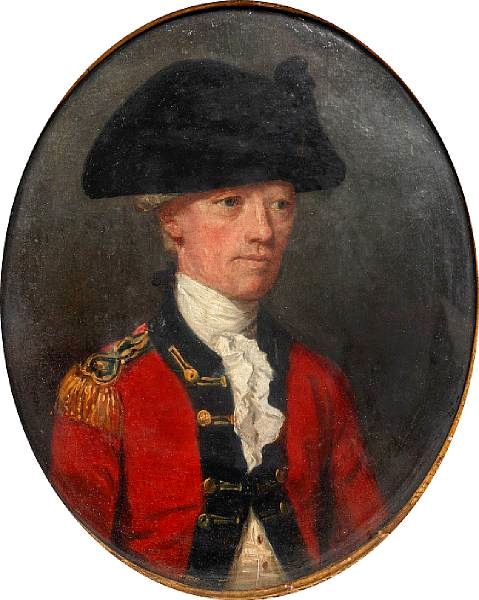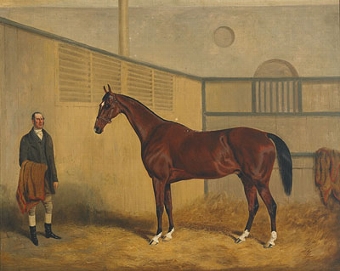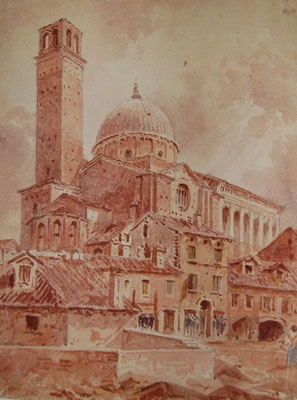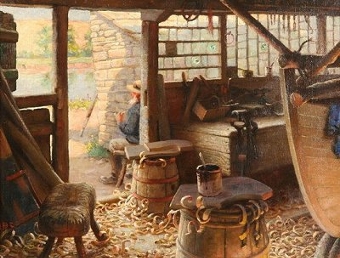William Howe, 5th Viscount Howe, KB, PC (10 August 1729 ? 12 July 1814) was a British army officer who rose to become Commander-in-Chief of British forces during the American War of Independence. Howe was one of three brothers who enjoyed distinguished military careers.
Having joined the army in 1746 Howe saw extensive service in the War of the Austrian Succession and Seven Years'' War. He became known for his role in the capture of Quebec in 1759 when he led a British force to capture the cliffs at Anse-au-Foulon, allowing James Wolfe to land his army and engage the French. Howe also participated in the campaigns to take Louisbourg, Belle ?le and Havana.
Howe was sent to North America in March 1775, arriving in May after the Revolutionary War broke out. After leading British troops to a costly victory in the Battle of Bunker Hill, Howe took command of all British forces in America from Thomas Gage in September of that year. Howe''s record in North America was marked by the successful capture of both New York City and Philadelphia. However, poor British campaign planning for 1777 contributed to the failure of John Burgoyne''s Saratoga campaign, which played a major role in the entry of France into the war. Howe''s role in developing those plans, and the degree to which he was responsible for British failures that year (despite his personal success at Philadelphia) have been a subject of contemporary and historic debate.
He resigned his post as Commander in Chief, North America, in 1778, and returned to England, where he was at times active in the defence of the British Isles. He served for many years in Parliament, and was knighted after his successes in 1776. He inherited the Viscountcy of Howe upon the death of his brother Richard in 1799. He married, but had no children, and the viscountcy was extinguished with his death in 1814.
William Howe was born in England, the third and youngest son of Emanuel Howe, 2nd Viscount Howe and Charlotte, the daughter of Sophia von Kielmansegg, Countess of Leinster and Darlington, an acknowledged illegitimate daughter of King George I. His mother was a regular in the courts of George II and George III.[2] This connection with the crown may have improved the careers of all three sons, but all were also very capable officers.[3] His father was a politician, who served as Governor of Barbados where he died in 1735. William''s eldest brother was General George Howe, who was killed just before the 1758 Battle of Carillon at Fort Ticonderoga. His other brother was Admiral Richard Howe, who rose to become one of Britain''s leading naval commanders.He entered the army when he was 17 by buying a cornet''s commission in the Duke of Cumberland''s Dragoons in 1746. He then served for two years in Flanders during the War of the Austrian Succession. After the war he was transferred to the 20th Regiment of Foot, where he became a friend of James Wolfe.
During the Seven Years'' War Howe''s service first brought him to America, and did much to raise his reputation. He joined the newly formed 58th Regiment of Foot in February 1757, and was promoted to lieutenant colonel in December of that year.[6] He commanded the regiment at the Siege of Louisbourg in 1758, leading an amphibious landing under heavy enemy fire. This action won the attackers a flanking position and earned Howe a commendation from Wolfe.
Howe commanded a light infantry battalion under General Wolfe during the 1759 Siege of Quebec. He was in the Battle of Beaufort, and was chosen by Wolfe to lead the ascent from the Saint Lawrence River up to the Plains of Abraham that led to the British victory in the Battle of the Plains of Abraham on 13 September 1759. After spending the winter in the defence of Quebec City,[6] his regiment fought in the April 1760 Battle of Sainte-Foy, and led a brigade in the capture of Montreal under Jeffery Amherst before returning to England. Howe led a brigade in the 1761 Capture of Belle ?le, off the French coast, and turned down the opportunity to become military governor after its capture so that he might continue in active service. He served as adjutant-general of the force that captured Havana in 1762, playing a part in a skirmish at Guanabacoa.
In 1758, Howe was elected a Member of Parliament for Nottingham, succeeding to the seat vacated by his brother George''s death. His election was assisted by the influence of his mother, who campaigned on behalf of her son while he was away at war,[6] and may very well have been undertaken because service in Parliament was seen as a common way to improve one''s prospects for advancement in the military. In 1764 he was promoted to colonel of the 46th Regiment of Foot, and in 1768 he was appointed lieutenant governor of the Isle of Wight. As tensions rose between Britain and the colonies in the 1770s, Howe continued to rise through the ranks, and came to be widely regarded as one of the best officers in the army. He was promoted to major general in 1772, and in 1774 introduced new training drills for light infantry companies.
In Parliament he was generally sympathetic to the American colonies. He publicly opposed the collection of legislation intended to punish the Thirteen Colonies known as Intolerable Acts, and in 1774 assured his constituents that he would resist active duty against the Americans and asserted that the entire British army could not conquer America. He also let government ministers know privately that he was prepared to serve in America as second in command to Thomas Gage, who he knew was unpopular in government circles. In early 1775, when King George called on him to serve, he accepted, claiming publicly that if he did not, he would suffer "the odious name of backwardness to serve my country in distress." He sailed for America in March 1775, accompanied by Major Generals Henry Clinton and John Burgoyne. In May 1775 his colonelcy was transferred to the 23rd Fusiliers.
Howe arrived at Boston on 25 May, having learned en route that war had broken out with the Battles of Lexington and Concord in April. He led a force of 4,000 troops sent to reinforce the 5,000 troops under General Thomas Gage that were besieged in the city after those battles. Gage, along with Howe and Generals Clinton and Burgoyne discussed plans to break the siege. They formulated a plan to seize high ground around Boston and then attack the besieging militia forces, and planned its execution for 18 June.[16] However, the colonists learned of the plan and fortified the heights of Breed''s Hill on the Charlestown peninsula on the night of 16?17 June, forcing the British leadership to rethink their strategy.
In a war council held early on 17 June, the generals developed a plan calling for a direct assault on the colonial fortification, and Gage gave Howe command of the operation. Despite a sense of urgency (the colonists were still working on the fortifications at the time of the council), the attack, now known as the Battle of Bunker Hill, did not begin until that afternoon.[18] With Howe personally leading the right wing of the attack, the first two assaults were firmly repulsed by the colonial defenders. Howe''s third assault gained the objective, but the cost of the day''s battle was appallingly heavy. The British casualties, more than 1,000 killed or wounded, were the highest of any engagement in the war. Howe described it as a "success ... too dearly bought." Although Howe exhibited courage on the battlefield, his tactics and overwhelming confidence were criticized. One subordinate wrote that Howe''s "absurd and destructive confidence" played a role in the number of casualties incurred.
Depiction of the Battle of Bunker Hill by Percy Moran, 1909
Although Howe was not injured in the battle, it had a pronounced effect on his spirit. According to British historian George Otto Trevelyan, the battle "exercised a permanent and most potent influence" especially on Howe''s behaviour, and that Howe''s military skills thereafter "were apt to fail him at the very moment when they were especially wanted." Despite an outward appearance of confidence and popularity with his troops, the "genial six-footer with a face some people described as ''coarse''", privately often exhibited a lack of self-confidence, and in later campaigns became somewhat dependent on his older brother Richard for advice and approval.
On 11 October 1775, General Gage sailed for England, and Howe took over as Commander-in-Chief of the British Army in America.[24] British military planners in London had, with the outbreak of hostilities, begun planning a massive reinforcement of the troops in North America. Their plans, made with recommendations from Howe, called for the abandonment of Boston and the establishment of bases in New York and Newport, Rhode Island in an attempt to isolate the rebellion to New England. When orders arrived in November to execute these plans, Howe opted to remain in Boston for the winter and begin the campaign in 1776. As a result, the remainder of the Siege of Boston was largely a stalemate. Howe never attempted a major engagement with the Continental Army, which had come under the command of Major General George Washington. He did, however, spend a fair amount of time at the gambling tables, and allegedly established a relationship with Elizabeth Lloyd Loring, the wife of Loyalist Joshua Loring, Jr. Loring apparently acquiesced to this arrangement, and was rewarded by Howe with the position of commissary of prisoners. Contemporaries and historians have criticized Howe for both his gambling and the amount of time he supposedly spent with Mrs. Loring, with some going so far as to level accusations that this behaviour interfered with his military activities; historian John Alden does not give these ideas credence. In January 1776 Howe''s role as commander in chief was cemented with a promotion to full general in North America.
The siege was broken in March 1776 when Continental Army Colonel Henry Knox brought heavy artillery from Fort Ticonderoga to Boston during the winter, and General Washington used them to fortify Dorchester Heights, overlooking Boston and its harbour. Howe at first planned an assault on this position, but a snowstorm interfered, and he eventually decided to withdraw from Boston. On March 17, British troops and Loyalists evacuated the city, and sailed for Halifax, Nova Scotia. Howe and his troops began to arrive outside New York harbour and made an uncontested landing on Staten Island in early July.[32] Howe, whose orders from Lord Germain, the London official responsible for the war, were fairly clear that he should avoid conflict before the arrival of reinforcements, then waited until those reinforcements arrived in mid-August, along with the naval commander, his brother Richard.[33][34] This delay proved to be somewhat costly, since the Americans used this time to improve fortifications on northwestern Long Island (at Brooklyn Heights) and increase the size of their army with militia.[34] After moving most of his army to southwestern Long Island without opposition, he attacked the American positions on August 27. In a well-executed maneouvre, a large column led by Howe and Clinton passed around the American left flank, routing the Americans from their forward positions into the entrenchments on Brooklyn Heights. Despite the urging of Clinton and others, Howe decided against an immediate assault on these fortifications, claiming "the Troops had for that day done handsomely enough."[35] He instead began siege operations, methodically advancing on the entrenched Americans.[36] This decision allowed General Washington to successfully orchestrate a nighttime strategic withdrawal across the East River on the night of August 29?30, aided by a thick morning fog.[37] Historian George Bilias notes that had Howe attacked Brooklyn Heights, the capture of even half of Washington''s army, and possibly Washington himself, might have had a significant effect on the rebellion.[35] Some officers, notably General Clinton, were critical of Howe''s decision not to storm the American works. Howe was knighted as a reward for his victory on Long Island.
Howe and his brother Richard had, as part of their instructions, been assigned roles as peace commissioners, with limited authority to treat with the rebels. After Long Island, they pursued an attempt at reconciliation, sending the captured General John Sullivan to Philadelphia with a proposal for a peace conference. The meeting that resulted, conducted by Admiral Howe, was unsuccessful. The Howes had been given limited powers, as had the Congressional representatives, and the latter were insistent that the British recognise the recently declared colonial independence. This was not within the Howe''s powers, so the conference failed, and Howe then continued the campaign.[39] He first landed troops on Manhattan on September 15, and occupied New York City (which then occupied only Lower Manhattan), although his advance northward on Manhattan was checked the next day at Harlem Heights.[40] He then paused, spending nearly one month consolidating control of New York City and awaiting reinforcements. During this time he ordered the execution of Nathan Hale for espionage, and had to deal with the effects of a major fire in the city. He then attempted a landing on the mainland at Throgs Neck, intending to flank Washington''s position at Harlem Heights. However, the narrow causeway between the beach and the mainland was well-defended, and he ended up withdrawing the troops. He then made a successful landing of troops at Pell''s Point in Westchester County; Washington managed to avoid being flanked, retreating to White Plains. Howe successfully forced Washington out of the New York area in the October 28 Battle of White Plains, and then turned his attention to consolidate British hold on Manhattan. In November he attacked the remaining Continental Army stronghold in the Battle of Fort Washington, taking several thousand prisoners.
Washington then retreated across New Jersey, followed by Howe''s advance forces under Charles Cornwallis.At this point, Howe prepared troops under the command of General Clinton for embarkation to occupy Newport, the other major goal of his plan. Clinton proposed that these troops instead be landed in New Jersey, either opposite Staten Island or on the Delaware River, trapping Washington or even capturing the seat of the Continental Congress, Philadelphia. Howe rejected these proposals, despatching Clinton and General Hugh, Earl Percy, two vocal critics of his leadership, to take Newport. In early December Howe came to Trenton, New Jersey to arrange the disposition of his troops for the winter. Washington had retreated all the way across the Delaware, and Howe returned to New York, believing the campaign to be ended for the season.[50] When Washington attacked the Hessian quarters at Trenton on 26 December 1776, Howe sent Cornwallis to reform the army in New Jersey and chase after Washington. Cornwallis was frustrated in this, with Washington gaining a second victory at Trenton and a third at Princeton. Howe recalled the army to positions much closer to New York for the winter.
Howe has been criticised by contemporaries and historians for failing to decisively defeat the Continental Army during the New York campaign. Contemporaries complained that his landing in Westchester failed to trap Washington, but failed to understand that his goal in the campaign was to secure Manhattan, and not necessarily to defeat Washington. However, historian George Billias observes that Howe''s overly rigid adherence to his plans meant that he was unable to capitalise on the opportunities that arose during the campaign for a decisive action.
On 30 November 1776, as Washington was retreating across New Jersey, Howe had written to Lord Germain with plans for the 1777 campaign season. He proposed to send a 10,000 man force up the Hudson River to capture Albany, New York, in conjunction with an expedition sent south from Province of Quebec. He again wrote to Germain on December 20, 1776 with more elaborate proposals for 1777. These again included operations to gain control of the Hudson River, and included expanded operations from the base at Newport, and an expedition to take Philadelphia. The latter Howe saw as attractive, since Washington was then just north of the city: Howe wrote that he was "persuaded the Principal Army should act offensively [against Philadelphia], where the enemy''s chief strength lies." Germain acknowledged that this plan was particularly "well digested", but it called for more men that Germain was prepared to provide. After the setbacks in New Jersey, Howe in mid-January 1777 proposed operations against Philadelphia that included an overland expedition and a sea-based attack, thinking this might lead to a decisive victory over the Continental Army. This plan was developed to the extent that in April Howe''s army was seen constructing pontoon bridges; Washington, lodged in his winter quarters at Morristown, New Jersey, thought they were for eventual use on the Delaware River.[58] However, by mid-May Howe had apparently abandoned the idea of an overland expedition: "I propose to invade Pennsylvania by sea ... we must probably abandon the Jersies."
When the campaign season opened in May 1777, General Washington moved most of his army from its winter quarters in Morristown, New Jersey to a strongly fortified position in the Watchung Mountains. In June 1777, Howe began a series of odd moves in New Jersey, apparently in an attempt to draw Washington and his army out of that position onto terrain more favourable for a general engagement.[61] His motives for this are uncertain; historian John Buchanan argues that Howe was determined to attempt to draw Washington into a major engagement while both were in northern New Jersey, writing that "Washington''s shift in position had whetted Howe''s appetite for a major action when, if everything went right, he would finally accomplish what he and his brother''s policies had denied him the previous year: the destruction of the Continental Army", but that Howe''s underlying campaign goal for the season was Philadelphia. One British major wrote that "[t]he report circulated by those in power is that it was thought necessary to march to Hilsborough[sic] to offer Washington battle." Americans like Henry Knox were perplexed but also concluded that was its purpose: "It was unaccountable that [the British] should stop short when they had gone only nine miles ... In the course of a day or two [we] discovered that they ... had come out with an intention of drawing us into the plain."Washington had intelligence that Howe had moved without taking the heavy river-crossing equipment, and was apparently not fooled at all.
When Washington failed to take the bait, Howe withdrew the army to Perth Amboy. Washington moved down to a more exposed position, assuming Howe was going to embark his army on ships. Howe then launched a lightning strike designed to cut Washington''s retreat off. This attempt was foiled by the Battle of Short Hills, which gave Washington time to retreat to a more secure position. Howe then did in fact embark his army and sailed south with his brother''s fleet. Howe maintained an effective secrecy surrounding the fleet''s destination: not only did Washington not know where it was going, neither did many British rank and file.
Howe''s campaign for Philadelphia began with an amphibious landing at Head of Elk, Maryland, southwest of the city in late August. Although Howe would have preferred to make a landing on the Delaware River below Philadelphia, reports of well-prepared defences dissuaded him, and the fleet spent almost an entire extra month at sea to reach Head of Elk. On 11 September 1777, Howe''s army met Washington''s near Chadds Ford along the Brandywine Creek in the Battle of Brandywine. In a reprise of earlier battles, Howe once again flanked the Continental Army position and forced Washington to retreat after inflicting heavy casualties. After two weeks of maneouvre, Howe triumphantly entered the city on 26 September. The reception the British received was not quite what they had expected, however. They had been led to believe that "Friends thicker than Woods" would greet them upon their arrival; they instead were greeted by women, children, and many deserted houses. Despite Howe''s best attempts to minimize the plundering by his army (he authorized the execution of violators of his orders against it), this activity by the army had a significant negative effect on popular support.
One week after Howe entered Philadelphia, on 4 October, Washington made a dawn attack on the British garrison at Germantown. He very nearly won the battle before being repulsed by late-arriving reinforcements sent from the city. This forced Howe to withdraw his troops a little closer to the city, where they were also needed to help clear the American Delaware River defences, which were preventing the navy from resupplying the army. It was late November before this task was accomplished, which included a poorly-executed attack on Fort Mercer by a division of Hessians.
Concomitant with Howe''s campaign, General Burgoyne led his expedition south from Montreal to capture Albany. Burgoyne''s advance was stopped in the Battles of Saratoga in September and October, and he surrendered his army on 17 October. Burgoyne''s surrender, coupled with Howe''s near defeat at Germantown, dramatically altered the strategic balance of the conflict. Support for the Continental Congress, suffering from Howe''s successful occupation of Philadelphia, was strengthened, and the victory encouraged France to enter the war against Britain. Burgoyne''s loss also further weakened the British government of Lord North.
Burgoyne made his advance under the assumption that he would be met in Albany by Howe or troops sent by Howe.] Burgoyne was apparently not aware that Howe''s plans evolved the way they did. Although Lord Germain knew what Howe''s plans were, whether he communicated them to Burgoyne is unclear. Some sources claim he did while others state that Burgoyne was not notified of the changes until the campaign was well underway. Whether Germain, Howe and Burgoyne had the same expectations about the degree to which Howe was supposed to support the invasion from Quebec is also unclear. Some historians argue that Howe failed to follow instructions and essentially abandoned Burgoyne''s army, while others suggest that Burgoyne failed on his own and then tried to shift the blame to Howe and Clinton.
Howe''s decision to focus his own activity on an expedition to Philadelphia may have been motivated by competition with General Burgoyne, who was given command of the northern force despite lobbying by Howe for its command to be given to Clinton.[81] John Alden notes the jealousies among the British leaders, saying, "It is likely that [Howe] was as jealous of Burgoyne as Burgoyne was of him and that he was not eager to do anything which might assist his junior up the ladder of military renown." Along the same lines historian Don Higginbotham concludes that in Howe''s view, "It [the northern campaign] was Burgoyne''s whole show, and consequently he [Howe] wanted little to do with it. With regard to Burgoyne''s army, he would do only what was required of him (virtually nothing)."
Howe himself wrote to Burgoyne on July 17 that he intended to stay close to Washington: "My intention is for Pennsylvania, where I expect to meet Washington, but if he goes to the northward contrary to my expectations, and you can keep him at bay, be assured I shall soon be after him to relieve you." This suggested that Howe would follow Washington if he went north to assist in the defense of the Hudson. Howe, however, sailed from New York on July 23. On August 30, shortly after his arrival at Head of Elk, Howe wrote to Germain that he would be unable to assist Burgoyne, citing a lack of Loyalist support in the Philadelphia area. A small force sent north from New York by General Clinton in early October was also unable to assist Burgoyne.
In October 1777 Howe sent his letter of resignation to London, complaining that he had been inadequately supported in that year''s campaigns. He was finally notified in April 1778 that his resignation was accepted. A grand party, known as the "Mischianza", was thrown for the departing general on 18 May. Organized by his aides John Andr? and Oliver De Lancey Jr., the party featured a grand parade, fireworks, and dancing until dawn. Washington, aware that the British were planning to evacuate Philadelphia, sent the Marquis de Lafayette out with a small force on the night of the party to determine British movements. This movement was noticed by alert British troops, and Howe ordered a column out to entrap the marquis. In the Battle of Barren Hill, Lafayette escaped the trap with minimal casualties.
On 24 May, the day Howe sailed for England, General Clinton took over as commander-in-chief of British armies in America, and made preparations for an overland march to New York. Howe arrived back in England on 1 July, where he and his brother faced censure for their actions in North America. It is likely that the resignation of both William and his brother Richard was due to their desire to hurry home to vindicate their conduct during the campaign. In 1779 Howe and his brother demanded a parliamentary inquiry into their actions. The inquiry that followed was unable to confirm any charges of impropriety or mismanagement levelled against either of them. Because of the inconclusive nature of the inquiry, attacks continued to be made against Howe in pamphlets and the press, and in 1780 he published a response to accusations levelled by Loyalist Joseph Galloway.
In 1780 Howe lost in his bid to be reelected to the House of Commons. In 1782 he was named lieutenant general of the ordnance and appointed to the Privy Council. His colonelcy was transferred from the 23rd Fusiliers to the 19th Light Dragoons in 1786. He resumed limited active duty in 1789, when a crisis with Spain over territorial claims in northwestern North America threatened to boil over into war. The crisis was resolved, and Howe did not see further action until 1793, when the French Revolutionary Wars involved Britain. He was promoted to full general in 1793, and commanded several outposts in the defence of Britain through at least 1795. That year he was appointed governor of Berwick-on-Tweed.
When his brother Richard died in 1799 without surviving male issue, Howe inherited the Irish titles and became the 5th Viscount Howe and Baron Clenawly. In 1803 he resigned as lieutenant general of the ordnance, citing poor health. In 1805 he was appointed governor of Plymouth, and died at Twickenham in 1814 after a long illness. He was married in 1765 to Frances Connolly, but the marriage was childless, and his titles died with him. His wife survived him by three years; both are buried in Twickenham
Antiques.co.uk Ref: P8F3ADCW
- Materials:
- Oil on Board
- Width (cm):
- 12 x 10 in. (31 x 26 cm.)











